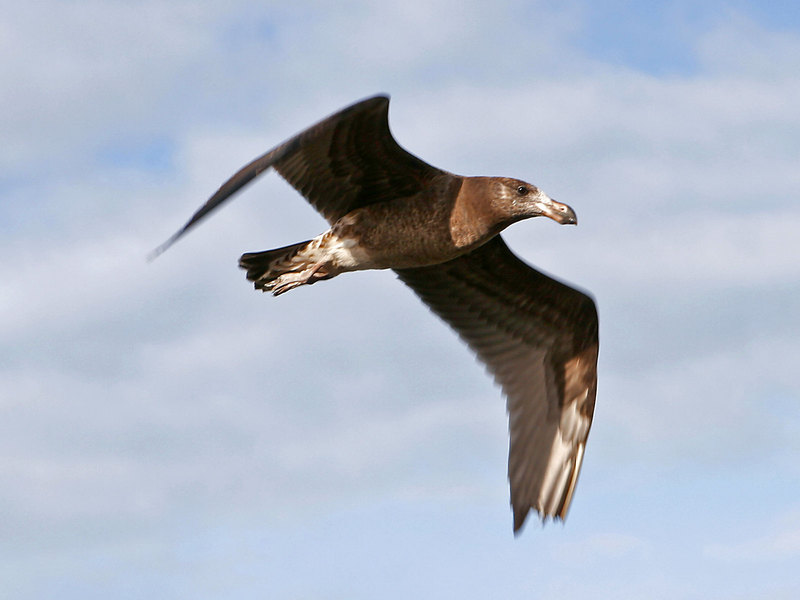|
| Query: Ocean guard | Result: 2nd of 16 | |
Pacific Gull (Larus pacificus) - Wiki
| Subject: | Pacific Gull (Larus pacificus) - Wiki
| |

| Resolution: 1600x1200
File Size: 141641 Bytes
Upload Date: 2006:12:09 21:18:57
|
Pacific Gull
From Wikipedia, the free encyclopedia
[Photo] Pacific Gull (Larus pacificus) - A juvenile pacific gull. Photo by http://en.wikipedia.org/wiki/User:Fir0002
The Pacific Gull (Larus pacificus) is a very large gull, native to the coasts of Australia. It is moderately common between Carnarvon in the west, and Sydney in the east, although it has become scarce in some parts of the south-east, as a result of competition from the Kelp Gull, which has "self-introduced" since the 1940s.
Much larger than the ubiquitous Silver Gull, and nowhere near as common, Pacific Gulls are usually seen alone or in pairs, loafing around the shoreline, steadily patrolling high above the edge of the water, or (sometimes) zooming high on the breeze to drop a shellfish or sea urchin onto rocks.
Adult Pacific Gulls range from 58 to 66 cm in length, and are white, with dark wings and back, and a powerful, red-tipped yellow bill. Young birds are mottled-brown all over, and attain their adult plumage only gradually: by its fourth year, a young Pacific Gull has usually become difficult to tell apart from an adult bird.
There are two subspecies: the nominate eastern race prefers sheltered beaches, the western race georgii is commonly found even on exposed shores. Both subspecies nest in pairs or loose colonies on offshore islands, making a cup of grasses and sticks in an exposed position, and laying two or three mottled brown eggs.
http://en.wikipedia.org/wiki/Pacific_Gull
| The text in this page is based on the copyrighted Wikipedia article shown in above URL. It is used under the GNU Free Documentation License. You may redistribute it, verbatim or modified, providing that you comply with the terms of the GFDL. |
|
Comments |
|---|
| | Guest |
|
Pacific Gull
Scientific name: Larus pacificus
Family: Laridae
Order: Charadriiformes
Featured Bird Groups
Sea birds
What does it look like?
Description
The Pacific Gull is a very large black-backed gull with a massive yellow bill, broadly tipped with scarlet. The upper wings and wingtips are wholly black with a narrow white inner trailing edge, the tail is white with a broad black band near the end. The legs are yellow to orange-yellow. Juvenile Pacific Gulls are mottled dark brown with pale face and the bill is pink with a black tip. The immatures have dark brown wings, whitish mottled body and a black-tipped yellow bill. There are two forms of the Pacific Gull: the eastern form (race pacificus) has a white eye and a complete red tip to the bill while the western form (race gergii) has a red eye and an incomplete red tip to the bill.
Similar species
The Pacific Gull can be confused with the Kelp Gull, Larus dominicanus, which has a much smaller bill, as well as being much smaller and less bulky.
Where does it live?
Distribution
The Pacific Gull is endemic to southern Australia and occurs mostly on south and west coasts, Tasmania and infrequently on the east coast.
Habitat
The Pacific Gull prefers sandy, or less often, rocky coasts and sandy beaches. In eastern Australia, the Pacific Gull prefers areas that are protected from ocean swells such as estuaries, bays and harbours. In Western Australia, it occurs occasionally in harbours but mostly on exposed coasts and offshore islands. It usually avoids human habitation but is occasionally seen on farmland and rubbish tips near the coast but rarely inland. It can be found roosting or loafing in elevated situations such as rocky headlands or on structures such as wharves and jetties.
Seasonal movements
The adult Pacific Gull is mainly sedentary while the young are dispersive.
What does it do?
Feeding
The Pacific Gull forages along the coasts between the high-water mark and shallow water on sandy beaches, feeding mainly on molluscs, fish, birds and other marine animals.
Breeding
The Pacific Gull breeds in scattered single pairs or small, loose colonies on high points on headlands or islands. Two types of nests are built: one a scrape or depression in the ground, either unlined or lined with small stones or gravel, the other is a neatly constructed shallow bowl made of sticks, grass, seaweed or feathers. Both sexes build the nest with the female doing most of the incubation while the male forages for food and stands guard near the nest.
Living with us
Living with humans
The Pacific Gull is easily disturbed by human activities at breeding sites and roosting areas, and have occasionally become entangled in fishing lines. However, they do scavenge on human refuse at rubbish tips, abattoirs, picnic areas and on fish scraps near wharves.
References
Pizzey, G. and Knight, F. 1997. Field Guide to the Birds of Australia. Angus and Robertson, Sydney.
Pringle, J.D. 1987. The Shorebirds of Australia. Angus and Robertson and the National Photographic Index of Australian Wildlife, Sydney.
Schodde, R. and Tideman, S.C. (eds) 1990. Reader's Digest Complete Book of Australian Birds (2nd Edition). Reader's Digest (Australia) Pty Ltd, Sydney.
Morcombe, M. 2000. Field guide to Australian Birds. Steve Parish Publishing.
Higgins, P.J. and S.J.J.F. Davies (eds) 1996. Handbook of Australian, New Zealand and Antarctic Birds, Volume 3 (Snipe to Pigeons). Oxford University Press, Victoria. |
^o^
Animal Pictures Archive for smart phones
^o^
|
|
|